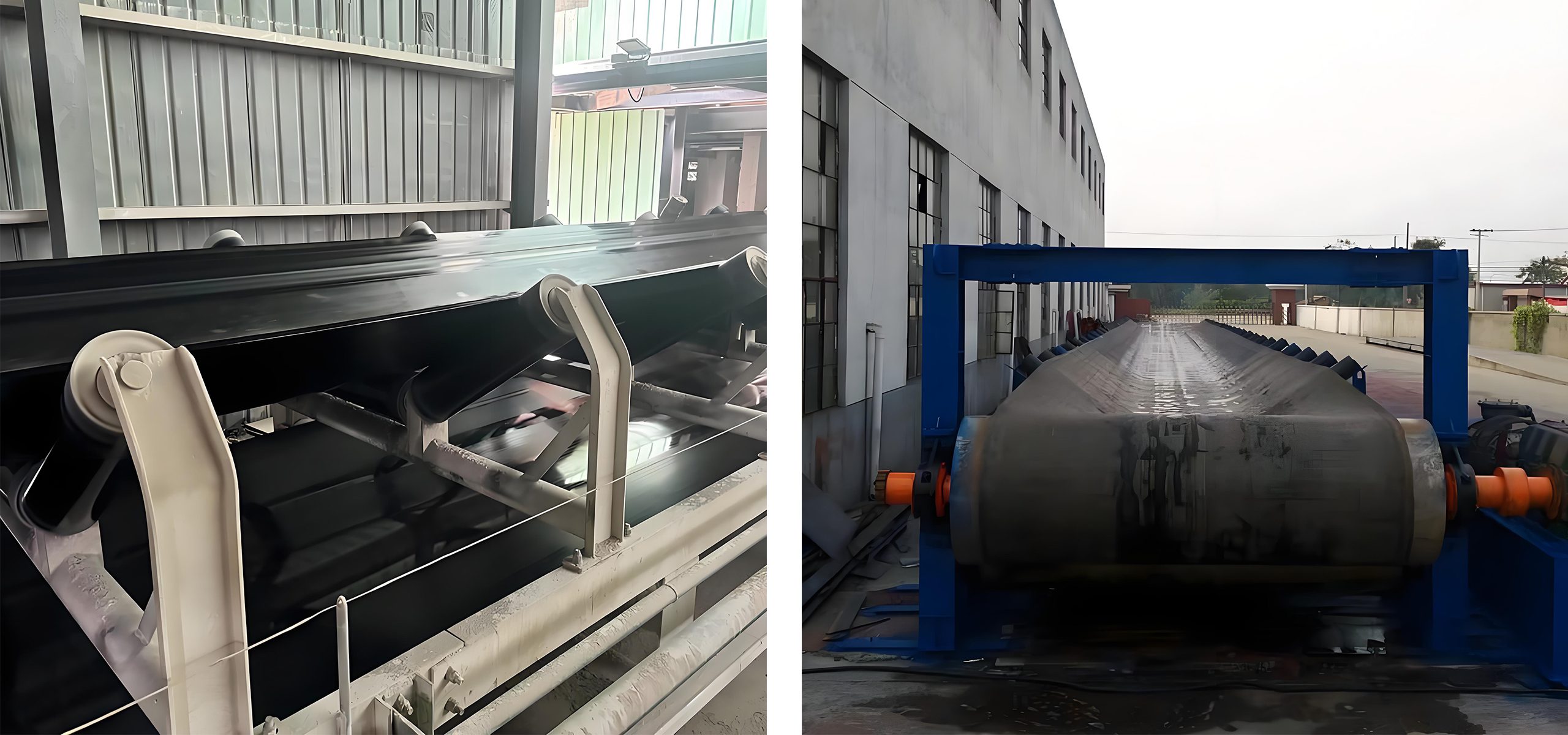ベルトのずれベルトコンベヤー トラッキング問題)は、バルクマテリアルハンドリングシステムで最も頻繁に発生し、コストのかかる問題の一つです。コンベアベルトが軌道から外れると、早期摩耗、材料の流出、さらにはシャットダウンの原因になります。このガイドでは、ベルトのミスアライメントの原因を分析し、業界の専門家が使用する実用的なコンベアベルトのアライメントソリューションを提供します。
ベルトコンベアの調整方法は?
1.ベルトのトラッキング(アライメント)のチェック
ベルトの動きを観察:コンベアを運転し、ベルトが片側に寄っていないか確認してください。
トラッキングローラー/プーリーの調整:
テール(ローディング)エンド:テールプーリーの片側にあるボルトを緩め、ベルトが動くように軽く調整します。
ヘッド(ドライブ)エンドにて:システムによってはトラッキングスクリューがあり、それを少し回してベルトのアライメントを調整します。
スナブローラーまたはアイドラーローラーを使用:このローラーの角度を調整し、ベルトを中央に戻します。
経験則:ベルトが動いている側を調整します(例えば、ベルトが左に流れている場合は、左側を少し前に調整します)。
2.ベルト張力の調整
スラックをチェック:ベルトは過度にたるまないようにしてください。
張力調整方法:
手動スクリュー調整:テイクアップアッセンブリーのボルトを緩め、プーリーを動かしてテンションを増減します。
グラビティ・テイクアップ:カウンターウェイトがあれば調整します。
油圧・空圧システム:圧力調整については、メーカーのガイドラインに従ってください。
適切な張力テスト:ベルトはわずかにたわみますが、負荷がかかっても滑らないものでなければなりません。
3.ローラー / アイドラーの点検と調整
すべてのローラーが
ベルトの方向に対して垂直。
ゴミや損傷がないこと。
スムーズに回転(焼き付いたローラーを交換)。
4.負荷分散のチェック
不均等な負荷はズレの原因となります。材料をベルトの中央に置いてください。
5.テストと微調整
コンベアを空運転にし、次に負荷をかけて、トラッキングが安定す るまで少しずつ調整します。
安全のヒント
調整前には必ずコンベアの電源を切り、ロックアウトしてくだ さい。
手袋を着用し、挟まれないようにしてください。
ベルトのずれが続く場合は、エッジの摩耗、プーリーの損傷、構造上の問題がないか点検してください。問題が続く場合は、専門家による修理が必要な場合があります。
コンベアベルトのズレはなぜ起こる?
核心的な問題は ベルト幅にわたる不均一な引張応力 または ローラー/ドラムによる横力.以下は、最も一般的な8つの原因です:
1.ヘッド/テールドラムのセンターのずれ
- 問題点:もし ヘッドドラムとテールドラムのセンター ベルトの長手方向の中心線がずれると、ベルトの長手方向の中心線がずれます。
- 修正:レーザーアライメントツールを使用して 公差 ≤3.0 mm (CEMA規格による)。
2.ローラーの不適切な位置決め
- 問題点: アイドラーローラーが垂直でない をベルトの中心線に押し付け、ベルトを横向きにします。
- 修正:チェック ローラーフレームアライメント 定規を使い、歪んだローラーを調整します。
3.不適切なベルトジョイント(機械式/加硫式)
- 問題点:A 接合不良 張力分布が不均一になります。
- 修正:について バルカンジョイント100%の幅の均一性を確保するため、メカニカルジョイントにはテーパーファスナーを使用してください。
4.ローラーフレームの緩みまたはずれ
- 問題点: ボルトの緩み またはフレームの変形によって ローラーグループ中心線.
- 修正:すべてのボルトを締め付け、確認します。 フレーム並列性 毎月
5.ベルトの損傷
- 問題点:一方のエッジがより摩耗している場合(ベルト端の損傷)、緊張のアンバランスが生じます。
- 修正:2%を超える場合は、リバーシブルベルトを回転させるか、または交換してください。
6.オフセンターローディング(材料排出ポイント)
- 問題点: 材料衝撃力 斜めになったシュートからベルトが横方向に押されます。
- 修正:インストール セルフセンタリングローディングシュート または調整可能なプラウ。
7.ローラー/ドラム上の材料の蓄積
- 問題点: 粘着性物質の蓄積 ローラーの直径を不均等に変えます。
- 修正:用途 たわし またはセラミックコーティングローラー。
8.重荷重による急激な衝撃
- 問題点: 大きな塊が落下 瞬時に横の力を発生させます。
- 修正:追加 インパクトベッド またはローディングゾーンのクッションゴム。
実績のあるベルトのミスアライメントソリューション
すぐに結果を出すためのクイックフィックス
- トラッキングアイドラーの調整:を回します。 トレーニングアイドラー ベルトがオーバーランしている側に向かって 15°。
- クリーンローラー:削除 物質蓄積 非金属のスクレーパーで。
長期的な予防戦略
- 自動追跡システムの導入 (例:PTスマートトラック)
- クラウンローラーへのアップグレード セルフセンタリング効果
- レーザーアライメントチェックの実施 クォータリー
よくある質問コンベヤベルトのトラッキングに関する質問にお答えします。
Q: コンベアベルトがずれているかどうかは、どうすれば分かりますか?
A: 以下のサインを探してください:
- ベルトがフレームと擦れる (ベルト端の損傷)
- 片側への材料流出
- 不均一な摩耗パターン
Q: ベルトのずれの原因は何ですか?
A:統計によると、40%の症例は、以下の原因によるものです。 不適切なローラーアライメント (CEMAレポート2023)。
Q: 破損したベルトがミスアライメントの原因になることはありますか?
A: はい! ベルトの不均一な伸び 張力分布の変化-6ヵ月ごとに厚みを測定。
オペレーターのための主なポイント
- 常に確認 ローラーの直角度 そして フレームアライメント メンテナンス中
- 投資 バルカナイズドスプライシング 長いベルトのためのメカニカルジョイントの上に。
- モニター 材料排出ポイント - 5°の傾きでもミスアライメントを引き起こす可能性があります。

ベルトコンベヤの運転では、ベルトのミスアライメントを注意深く監視することが不可欠である。ベルトコンベヤの運転では、ベルトのズレを注意深く監視することが不可欠です。原因の適時特定と適切な対策の実施は、効率的で安定した運転を維持するための鍵です。これらの是正措置に従うことで、ミスアライメントに関連するリスクを効果的に低減し、生産効率を高めることができます。 お問い合わせ!私たちはあなたを助け、サポートします。

